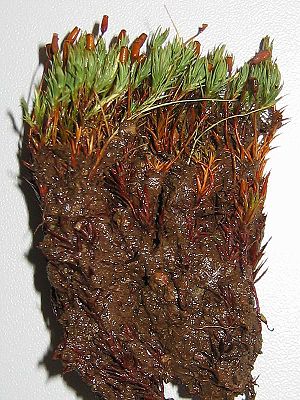Large felt hat moss
| Large felt hat moss | ||||||||||||
|---|---|---|---|---|---|---|---|---|---|---|---|---|

Large felt hat moss ( Pogonatum urnigerum ) |
||||||||||||
| Systematics | ||||||||||||
|
||||||||||||
| Scientific name | ||||||||||||
| Pogonatum urnigerum | ||||||||||||
| ( Hedw. ) P. Beauv. |
The large felt hat moss ( Pogonatum urnigerum ), also called urn-bearing felt hat moss or large felt hat , is a character moss of the low and high mountains of Europe.
Identifying features
The little plants of the large felt hat moss are between 2 and 6 cm tall, are bluish green in color and turn brown with age. The stems are usually forked upwards. There is a risk of confusion with Polytrichum alpinum , which, however, mostly occurs in slightly more humid locations and is distinguished by the green stem, the rounded end cells and the larger leaf sheath (up to 30% of the leaf length). Polytrichum formosum forms darker leaves and is mostly found in the forest undergrowth.
The tightly standing, narrowly lanceolate leaves become gradually larger towards the top and are between 5 and 7 mm long. When dry they lie close together, when wet they are usually clearly protruding. The sheathed leaf base is hyaline and can make up about 20% of the leaf length. The leaf edge is serrated by multi-cell saw teeth. The leaf vein emerges as a short spike tip. The inverted oval, enlarged end cells of the numerous assimilation lamellae are characteristically papillary at the tip . The thick-walled lamina cells are more or less rectangular and between 15 and 50 µm in diameter. The seta , which is red at the bottom and pale red on the top , is about 2 to 5 cm long and has upright, cylindrical, red-brown capsules, the peristome teeth of which are red-brown in color and have a colorless edge. The rounded capsule lid forms an extremely short beak. The spores are between 14 and 18 µm in size and have a weak papillae.
Occurrence
The Großer Filzmützenmoos populates light-rich, sandy to gravelly, nutrient-poor and lime-poor, fresh and humid locations. It is widespread on low-humus forest paths in montane mountain regions, in open-ground, sandy and gravelly places on silicate rock. The moss is relatively rare in the lowlands. Sometimes it is even endangered there. Its main area of distribution is submontane to subalpine altitudes. Otherwise the moss can be found in the rest of northern Europe and parts of Asia, in North America and in the high mountains of Africa.
literature
- Wolfgang Frey , Jan-Peter Frahm , Eberhard Fischer, Wolfram Lobin : The moss and fern plants of Europe (= small cryptogam flora. Vol. 4). 6th, completely revised edition. Fischer, Stuttgart et al. 1995, ISBN 3-437-30756-8 .
- Martin Nebel, Georg Philippi (ed.): The mosses of Baden-Württemberg. Volume 1: General part, special part (Bryophytina I, Andreaeales to Funariales). Ulmer, Stuttgart 2000, ISBN 3-8001-3527-2 .
- Volkmar Wirth , Ruprecht Düll : Color Atlas of Lichen and Moss. Ulmer, Stuttgart (Hohenheim) 2000, ISBN 3-8001-3517-5 .


